The global AI in cybersecurity market, at $22.4 billion in 2023, is set for a dramatic change. Experts predict that the industry's market value will reach $ 60 billion by the year 2028. This high annual average growth rate of 21.9% shows the impressive growth trajectory of this astonishing rise.
The article examines how AI shapes cyber-security with reference to safeguarding the digital space and developing appropriate defenses against evolving threats. Come with us as we explore how modern AI is used in the provision of digital security.
Top 10 Applications of Artificial Intelligence in Cybersecurity
Here are the 10 key ways in which Artificial Intelligence can be applied in cybersecurity:
1. Automated SSL Certificate Management
AI is also able to effectively and automatically manage various types of SSL certificates- from Domain Validated (DV) to Extended Validation (EV) and even the most budget-friendly SSL certificates . This is demonstrated in the use of modern tools such as Venafi and Netscaler ADM that ease the tasks of generating and managing the certificates.
Organizations can leverage AI algorithms to monitor and keep their SSL certificates current and secure. Such AI-endowed systems track certificate aging and replace or renew them just in time. It's especially good for firms that have installed dozens of SSL certificates. Apart from easing the administrative burden, this prevents the problem of expiring certificates, which helps improve the organization's security stance.
2. Threat Intelligence and Analytical Insights
Cybersecurity management has some core elements, such as threat intelligence and analytical insights. In particular, Artificial Intelligence plays a paramount role in accumulating, processing, and analyzing immense data for the purposes of detecting possible threats. For this purpose, organizations can utilize AI that is powered by machine learning algorithms to recognize peculiarities and potential threats as signs of compromise ahead of any cyber attackers. AI-driven threat intelligence gives the opportunity to provide real-time updates about potential vulnerabilities and threat actors in order to strengthen defensive mechanisms, take reasonable actions, and manage resources prudently. It serves as a force multiplier in the current war on cyber assets, enabling organizations to foresee and prevent dangers.
3. Malicious Software Detection
Malware, or malicious software, puts digital security at risk all the time. But the war against malware has now become proactive using artificial intelligence. Malicious code detection systems driven by artificial intelligence analyze the coding behaviors, attributes of the files, and network activities in order to reveal the unknowns. The anti-virus algorithms use machine learning, so they always keep up with every possible virus (for instance – computer virus, ransomware, and so on). The automation of AI saves time and is considerably more effective than conventional processes for companies to stay a step ahead of malware attackers.
4. AI for Security Log Analysis
Artificial intelligence enhances modern cybersecurity with the help of security log Analysis. AI-based algorithms can process big data of the logs from firewalls, IDSs, and servers for uncovering patterns, anomalies, and signs indicating cyberattacks. Auto logging and matching will enable AI to detect the threats on the go. Such equipment helps incident response departments respond faster to security incidents and mitigate damage caused by information breakage. Such log analysis also improves the organization's incident management by providing valuable data for the strengthening of the defenses against the same threats in the future.
5. Enhanced Phishing Threat Identification
The art of phishing is still in vogue, as people are made to believe the fake email and website messages so that they give out their secrets. Artificial intelligence has made it possible to detect and prevent phishing attacks. Real-time machine-based learning is used for the determination of the phishing attacks done on email content, the behavior of senders, and website properties. An incoming message is quickly compared against various AI-generated suspected phishing patterns in a bid to tag and flag the message as a scam before it becomes successful. Continuous learning and change enable AI to remain sensitive to new phishing attack tactics, thus further strengthening security.
6. AI-Driven Network Security and Monitoring
Advances in AI network defense capabilities have completely revamped the definition of network security, which safeguards various digital systems. AI-driven network security may involve using machine learning to identify abnormal activities on a network that may signal the occurrence of cyber-attacks. It also identifies and responds to malicious activities such as DDoS attacks and peculiar behavior with regard to data access. The enhanced AI, which is efficient in responding to network defense, is based on the emergence of new threats and vulnerabilities. The active and effective security team ensures that the organization's network is automated, thus strong enough to resist emerging threats.
7. Harnessing Behavioral Analysis with AI
Behavioral artificial intelligence analysis is a new frontier in cyber security. Learning through AI-driven systems defines the usual patterns of user behavior and the work of equipment connected to the network. Using this system, they can spot irregularity, different behavioral patterns, and strange acts indicative of intrusion or suspicious activity. By continuously analyzing these patterns, artificial intelligence is able to identify insider threats and unauthorized external intrusion in a short period of time. In this regard, AI-enabled behavioral analysis is superior than usual in recognizing as well as dealing with cases of unauthorized access within an organization. It also increases the prevention and early response, therefore mitigating cases of compromised integrity like data breaches or malware.
8. User Verification and Access Management
Currently, AI is making strides in user verification and access control, among others. There are several ways through which AI-based systems strengthen the user authentication process, such as multi-factor authentication, biometrics, and behavioral analysis. These technologies improve safety and ensure a smooth customer flow. In addition, AI enables adaptive access control because it continuously keeps track of user activities and immediately responds by changing permission settings if they misbehave or attempt to break into some parts of the system unauthorisedly. It assists in cutting the chances of external and internal threats. By using AI in user verification and management, they are able to strike a perfect balance between usability and security. It guards against unauthorized use, and it is non-frustrating to legitimate users.
9. Combating Security Complacency
One problem security experts have constantly faced in cybersecurity is instances of security complacency. With advancing complex technological and security systems, there is always a temptation to be more vulnerable since they believe these defenses are impregnable. AI tackles this complacency by providing continuous monitoring as well as active surveillance and identification of threats before they occur. AI systems continuously monitor network traffic, user behaviors, and device activities for minor changes that might suggest a breach. This way, AI ensures that companies maintain alertness to emerging threats. Furthermore, it keeps reminding us that cybersecurity is never completed because there will always be sophisticated attackers who need to be countered.
10. Securing the Internet of Things (IoT)
IoT security is critical because the proliferation of IoT devices has broadened the IoT attack surfaces for cyber threats. AI forms an important protective layer for IoT environments by continuously observing device conduct, picking out anomalies, and limiting possible dangers. The machine learning algorithm analyses data from IOT devices, seeking pattern that shows weakness or cyber attack. AI also helps implement access controls and limits only sanctioned devices to operate the Internet of Things. Besides, AI-based anomaly detection keeps IoT networks free from unauthorized access and hostile acts, making IoT environments safer and stronger for cyber threats.
Conclusion
Cybersecurity is undergoing a fast transformation into its artificial intelligence aspect that gives multi-faceted strength to its defense. As an effective helpmate in defending against cyber threats, AI comprises various aspects, from identifying malicious software and phishing schemes to response automation and behavioral analytics. This helps organizations to be more preemptive and respond promptly to changes that come up daily in the fast-paced digital world. Besides that, AI is beneficial in enhancing authentication and governance against the security assumption. AI ensures security in an increasingly complex ecosystem of connected things. With cybersecurity challenges developing every day, AI remains a must-have for securing digital possessions in an interdependent global village.





Leave a Comment on this Post